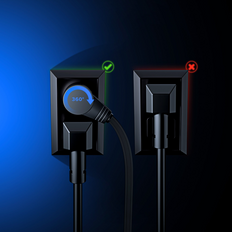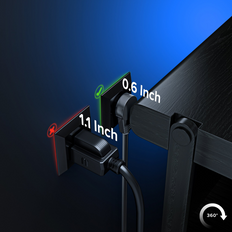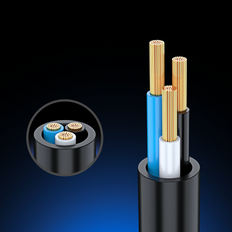-
-
360° Degree Rotating Flat Extension cord, 16 AWG - Black - 3 FT
ADW-360-31F03-16B0 -
-
Extension Cord Power Cords Indoor 16 Gauge Wire Heavy Duty ETL Listed - 1 FT - Orange
OBK-ISW-04K-05H-OR-BK -
3-Outlet Extension Cord, Indoor/Outdoor SJTW - 3 FT - Black (White Inserts)
IGR-LA004H-LA052DA-03-WHBK -
Flat Plug Extension Cord, 16 Gauge - 10 FT
CFI-WHGRN-04H/052P-10FT -
Extension Cord with On/Off Foot Switch and Safety Cover, 3 Outlets - 4 FT
Light-P020P-LA002H-04 -
-
Indoor Extension Cord with Built-In Loop, 3 Outlets - 6 FT - Green
ADW-LA052T-06GRN
Space-Savvy Features That Make Life Easier
Space-Savvy Features That Make Life Easier
Furniture sits closer to the wall when the plug doesn’t get in the way. A flat or rotating head on an indoor extension cord reduces clearance needs and helps protect outlets from strain. Angled designs guide the cord in the right direction, so dressers, nightstands, and TV consoles can stay put without pinching cable jackets. This kind of ergonomic plug also keeps nearby receptacles open for other devices.
Device clusters benefit from compact distribution. Multi-outlet ends power lamps, speakers, and streaming boxes without a bulky strip. Add-ons like lighted tips confirm live power at a glance. A clean, low-profile indoor extension cord supports daily use in living rooms, bedrooms, offices, dorms, and studios while keeping wiring discreet.
Some buyers type under-rug extension cord when they really want invisible routing. Covering cords with rugs traps heat and invites wear. A better plan uses cord channels, baseboard raceways, or floor covers rated for cable. Pick an indoor extension cord in the right length to avoid loops, then route along edges for a safer, cleaner look.
Dial in Length, Capacity, and Control
Dial in Length, Capacity, and Control
Start with distance. Short 1–3 ft jumpers eliminate blocked outlets. 6–15 ft suits desks and entertainment setups. 25–50 ft spans larger rooms and flexible layouts. Choosing the right indoor extension cord length reduces slack and helps prevent tripping hazards.
Match capacity to the load. An indoor extension cord serves lamps, chargers, game consoles, and small electronics well. Space heaters, shop vacuums, and large motor tools call for heavier gauges in dedicated categories. Keeping loads aligned with ratings preserves performance and extends cord life.
Style and control matter too. White blends into baseboards; black disappears behind AV gear; bright colors stand out for quick ID. Foot switches and mounting brackets add convenience in hard-to-reach spots. Browse lengths, plug profiles, and outlet styles, then add the indoor extension cord that fits your room.
Frequently Asked Questions
What length of extension cord should I choose?
When choosing an extension cord, select a length that comfortably reaches your device without leaving excessive slack. Always match the cord length to your setup to ensure safe, reliable performance.
Can extension cords be used outdoors?
Yes, but only if it's an outdoor-rated extension cord. Outdoor extension cords have thicker insulation and are built to withstand exposure to moisture, sunlight, and extreme temperatures. These cords usually have three prongs for grounding and are labeled for outdoor or weather-resistant use. Using an indoor cord outdoors can result in damage to the cord or even pose safety risks. If you plan to power tools, lighting, or holiday decorations outside, always choose an outdoor-rated extension cord designed for safe, long-term use.
How do I know the extension cord can handle my devices?
To ensure an extension cord can safely power your devices, check its gauge (AWG rating) and maximum amperage or wattage rating. A lower gauge number means a thicker wire and higher power capacity. For example, a 12-gauge cord can handle more load than a 16-gauge cord. Match the cord’s power rating to your devices, and add up the wattage or amperage of everything you plan to plug in. For high-wattage equipment like heaters or power tools, use a heavy-duty extension cord with high-capacity ratings to prevent overheating or tripping the circuit.
How should I store an extension cord?
To maximize the lifespan and safety of your extension cord, store it correctly. Once unplugged, loosely coil the cord in a circle or figure eight to prevent damage. Use a cord wrap, hook, or hanger to secure it in place. Keep the cord in a dry, cool area, away from direct sunlight, moisture, and heat sources. Don't coil cords tightly or place heavy items on them; this can damage the insulation. Regular inspection during storage helps catch damage early and ensures your cord is always ready for use.
Can I plug one extension cord into another?
It’s not recommended to plug one extension cord into another, also known as “daisy chaining.” This can create a serious safety hazard by increasing electrical resistance, which may lead to voltage drop, overheating, or even a fire. If you need a longer cord, it’s safer to use a single extension cord that’s long enough and properly rated for your power needs. For longer distances, choose a heavy-duty extension cord with a lower gauge number to handle the extra load without compromising performance.
What's the difference between light-duty and heavy-duty extension cords?
Light-duty extension cords are typically thinner and designed for small, low-power devices, such as lamps, phone chargers, or alarm clocks. They usually have a higher gauge number (like 16 or 18 AWG) and lower amperage capacity. In contrast, heavy-duty extension cords are designed to handle more power-hungry devices such as space heaters, power tools, or outdoor equipment. These cords have thicker wires (like 12 or 14 AWG) and can safely carry more current over longer distances. Always match the cord type to the power needs of your devices to avoid damage or safety issues.

























































